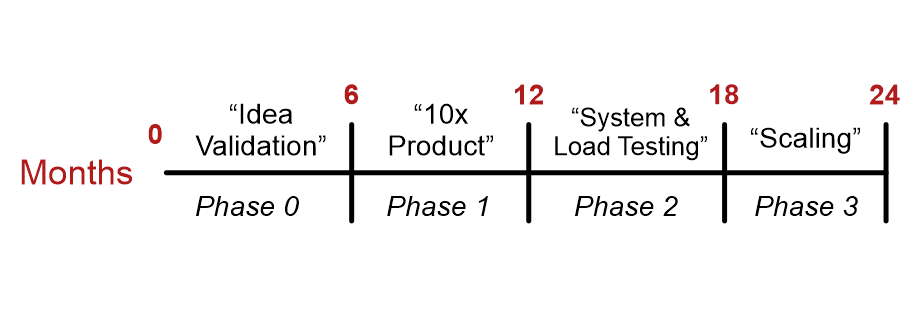How much time does it take to go from idea to startup? When to scale 10x? What is the best time to raise funding?
I couldn’t get practical answers to these questions while starting WhiteHat Jr.
So here I put together a step-by-step 24 month timeline from setting up to scaling a startup, based on one journey. Your actual timings will vary, of course, but the phases below should be a good indicator of a startup trajectory. I hope these are useful for you to go from idea to a full-fledged company.
First off, here is WhiteHat Jr’s rough 24-month timeline from Start to Scale

Month 0 is when I first got the idea.
I didn’t incorporate a company until I validated the idea over the next 3 months, then raised Seed funding.
Then, there were 3 distinct phases of roughly 6 months each from building a product to scaling the company to $100MM+ revenue.
Next, here is a chart I wished I’d seen when I was fundraising because I kept searching for revenue targets for the next round of funding.
WHJ Funding raised before the start of each phase and the annualized revenue at the end or the last month of the phase.
| Phase | Phase Start-End Timing | Phase-Start Funding Amount Raised ($MM) | Phase-End Annualized Revenue¹ ($MM) | |
|---|---|---|---|---|
| 0 | “Idea Evaluation” | Jul’18-Nov’18 | – | – |
| 1 | “10x Product” | Dec’18-June’19 | Seed- $1.3 MM | $2 MM |
| 2 | “System Set Up & Load Testing” | Jul’19-Feb’20 | Series A-$10MM | $12 MM |
| 3 | “Scaling” | Mar’20-Aug’20 | -² | $100 MM+ |
¹Annualized Revenue calculated as Monthly Booking Revenue x 12. Eg Phase 1 Annualized Bookings Revenue is July’19 Monthly Booking Revenue x 12.
²Series B Funding Planned at $50MM but turned mid-way into BYJU’s acquisition. We scaled to $100MM+ without funding since we were cash-flow positive.
Funding “Middle-Way” Golden Rule
Start fundraising for the next phase right in the middle of the previous phase.
Example, we started our Series A fundraise in Mar’ 2019 when we were still readying the 10x product and monthly revenue was half-way to our goal.
If you go earlier than in the middle, you won’t have enough progress to show versus the previous round, reducing valuations.
But going later is worse. Tech startups are “Winner-takes-all” or “Winner-takes-most” plays. And cash is oxygen to never lose momentum in a category you created from scratch as well-funded competitors step in.
For more details on fundraising and valuations, please read this post. Or post a comment if you have questions. I will answer each comment on this post promptly.
Finally, what are key activities and milestones for each Phase? I have covered in detail in previous blogs but here is a quick summary:
- Phase 0: Idea Evaluation- 0-6 Months
I shared the WhiteHat Jr idea with the CEO of one of India’s largest tech companies the day I came up with it. He said it was too ahead of its time and would never work.
No one can predict a startup’s outcome.
StartUps lie at the edges of systems, not at the center of it. Hence opinions, even experts, are seldom correct.
Your #1 activity in this phase, therefore, is to create a zero-code/low-code prototype immediately.
WHJ Prototype Phase 0-<6 Months
Full-Time Employees: 0;
Prototype Cost: <$1000

And your success milestone is to get your first paying customer.
If you get 30 paying customers, who’s not friends or family, you can create a category at scale.
For more details on creating and selling a low-code prototype, please read this post. Or post a comment if you have questions.
- Phase 1: “10x Product” Phase- 6-12 Months³
I was in the middle of a meeting with one of our seed investors in the 10x phase when I picked up a customer service call. We paused the meeting while I fixed the customer’s live-class camera settings issue. Our investor asked me the same question everyone was asking me in this time:
Why wasn’t I building a team despite having seed funding?
Later, they asked it less politely,
Why was I so slow in hiring even for entry-level positions? Had I really headed a business before at Discovery?
You need a 10x product to scale.
Else the business model will break at scale.
We had defined these 10x milestones based on our business model- 50% NPS, 50% Renewal Rates, 50% Revenue from Referrals. And I kept costs unforgiving low until we hit these numbers.
Full-Time Employees: <20

Define your 10x milestones. Then, have just a small “hacker, designer, marketer” collection of folks speaking to customers and releasing new features daily until you hit this milestone.
For more details on creating a 10x product, please read this post. Or post a comment if you have questions.
- Phase 2: “System Set Up & Load Testing” Phase- 12-18 Months
I’d wake up with a feeling of dread every weekend for months. We knew our code would break somewhere during the day as demand surged ahead of systems. And every Sunday would be a series of frantic phone calls to find the root-cause and fix remotely.
Systems rarely keep up scale when you have a 10x product. So “System & Load Testing” phase is characterized by:
- System Set-Up
– Management: Build an A-Team to build an A-Company. Your team in this phase will build the full plumbing of the company. You can read more details on hiring here.
– Tech, Data & Customer Support Systems: Refactor or Rewrite old code to build code that can scale. You can read more details on systems scaling here.
– HR, Legal, Finance, and Support Functions: Very critical as the company enters the highly visible scaling phase-there’s no forgiveness for an adult acting like a teenager in public! I was late on this one, a mistake I’d correct in retrospect.
- Load-Testing Unit Economics
– Do the customer acquisition costs(CAC) hold at scale? Are you generating positive unit-economics with a benchmark 3:1 LTV:CAC ratio? Business reality and investor decks have to converge now. Because at scaling, unit economics become real. If you lose money with each unit, scaling becomes impossible as your cash burn goes up exponentially with each unit sold.
WHJ Systems Set Up & Load Testing Phase 12-18 Months
Full-Time Employees: 200

- Phase 3: “Scaling” Phase-18-24 Months
You don’t need any blogs if you’ve successfully entered this phase! But there are three key hires overlooked at the scaling phase which I’d recommend to every startup:
1. Multi-Threaded Innovation Leader: You should create a multi-threaded innovation architecture even as you’re thick in the middle of scaling your core single product, so you’re prepared for the next phase of growth. For us, this meant investing in Maths, Music, and B2B, even as the core product of Coding was scaling in India and US.
2. Values Champion: Your values will break with scaling, unless deeply articulated and repeated daily, hence a dedicated daily values/culture/training champion, distinct from Human Resources which gets fully consumed by operations in scaling, is key. I regret hiring this role late.
3. CEO’s Office/Entrepreneur-in-Residence: New fires burn daily and you need people beyond defined functional responsibility to douse them. We put 1-2 top ex MBB (Mckinsey/BCG/Bain) management consultants who rotated magnificently to solve our toughest problems from scaling recruiting 100x to setting up sales training. I recommend getting this role in Phase 2 itself.
WHJ Scaling Phase 18 Month+
Full-Time Employees: 5000+

I hope this is a helpful framework to plan the next few years of your life! And if you have any specific questions on any phase, please let me know in the comments. I will answer each comment on this post promptly, as I found lots of motivational but very few practical frameworks in my time spent building WhiteHat Jr! My best to you always on your soon-to-be incredible journey.
And if you found this useful, you may also like this new YT Video (<5 Minutes) on How to Turn Failure Into Success.
Please subscribe to the channel here for 3x new videos/week on startup and success models.
³WHJ Approx Timeline. Your timeline will vary but the phase should be similar!

















19 Comments